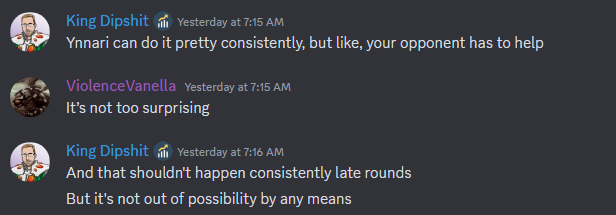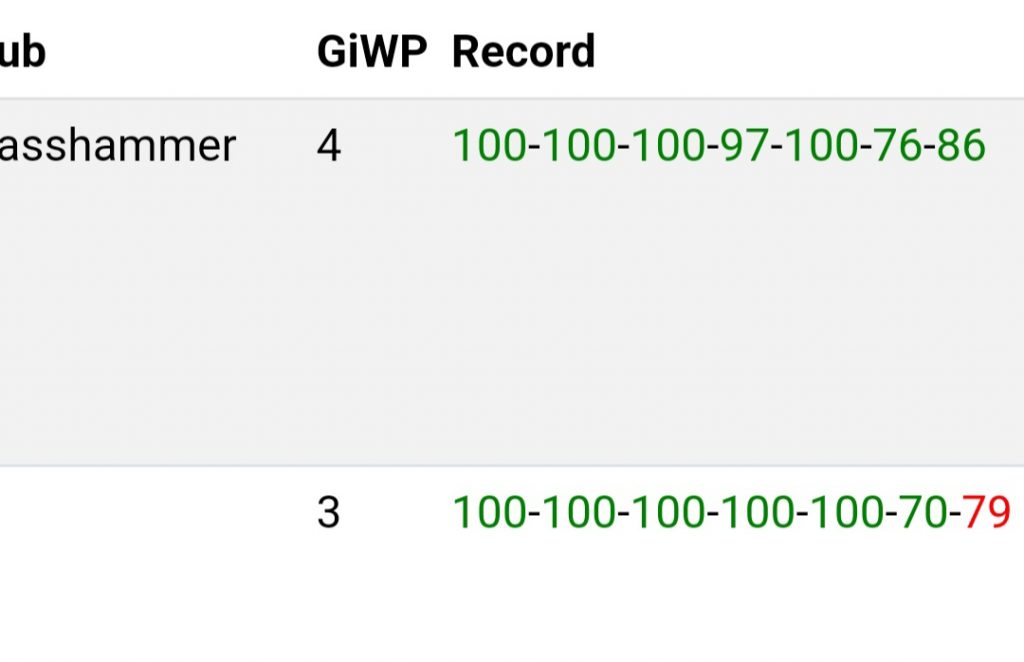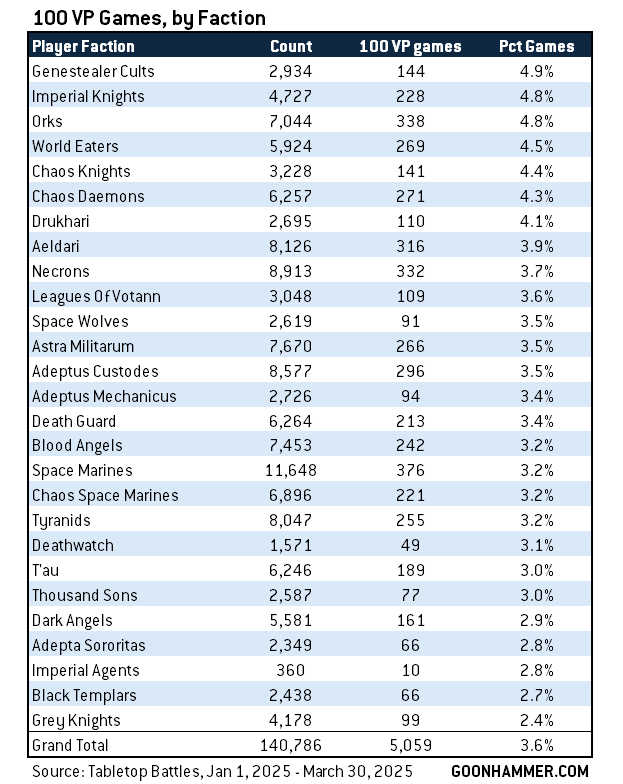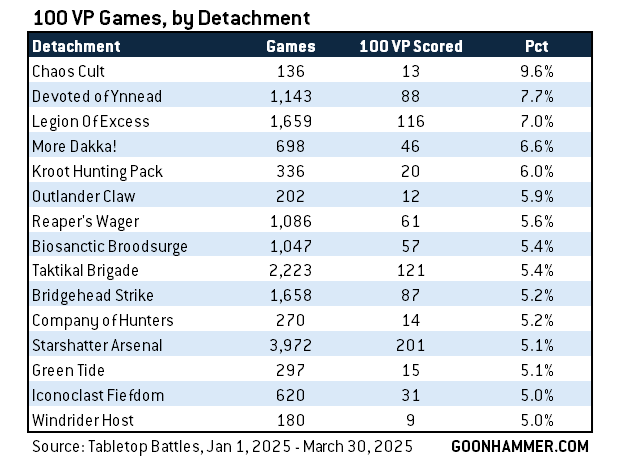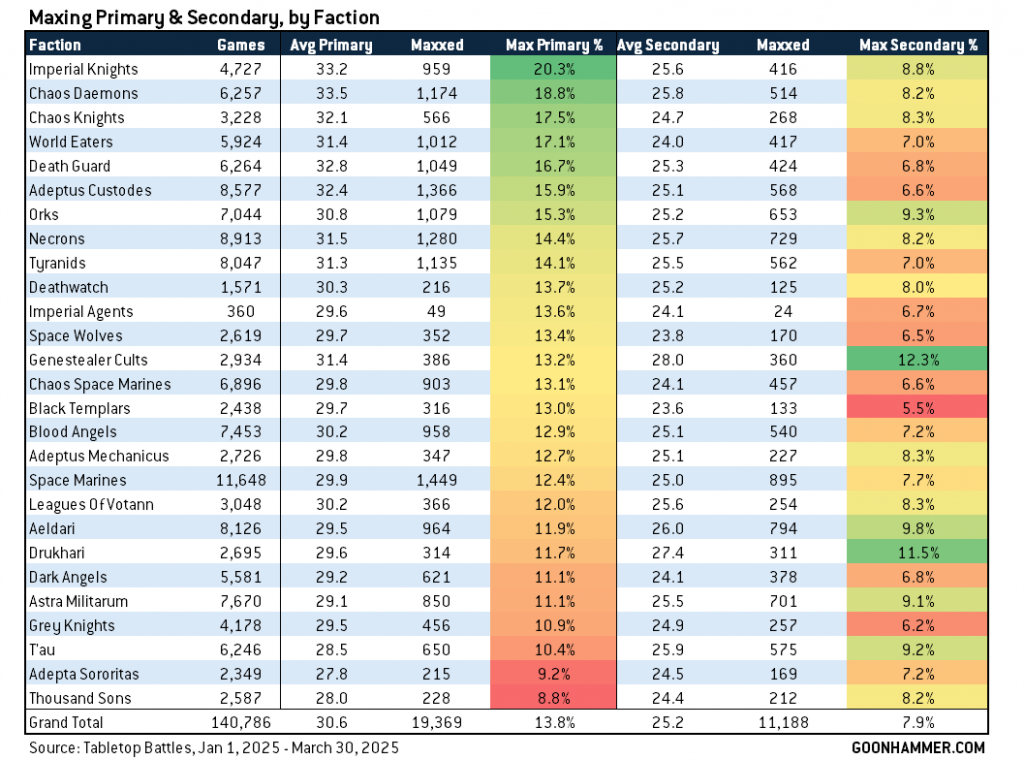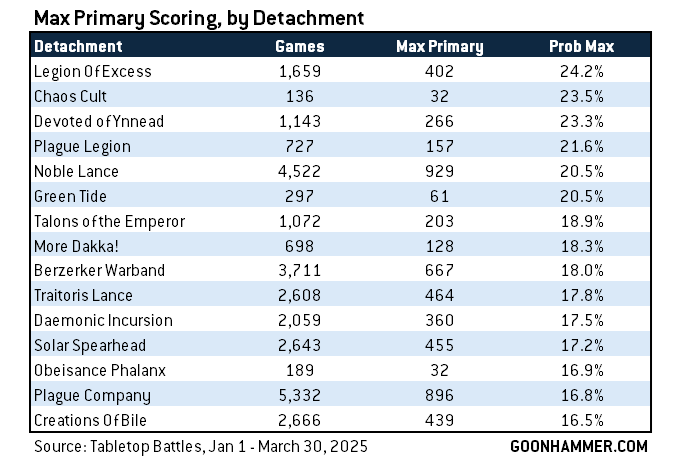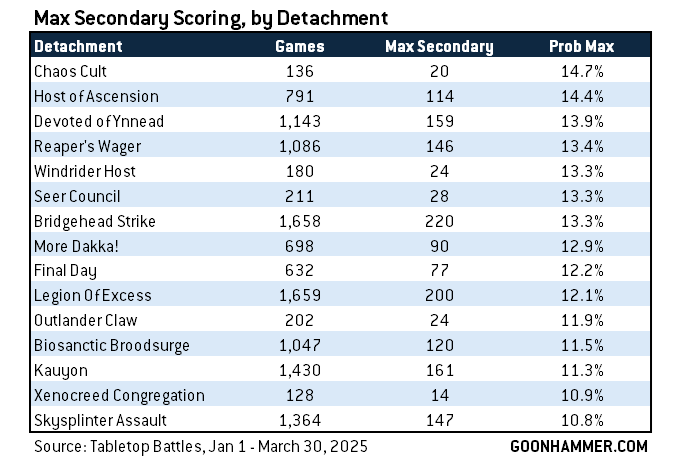In Hammer of Math, we look at key topics in Warhammer and tabletop games that involve probability, math, and statistics, looking at how these factors influence the game. This week we’re starting a multi-part miniseries on scoring in games of Warhammer 40,000.
There’s a secret Discord channel on the Goonhammer server where our best competitive players hang out. Also I’m in there, because I’m a server admin and they can’t keep me out. It’s where we have a lot of our discussions around top lists and builds, meta developments, and it’s just generally a great place to bounce ideas off each other when it comes to creating competitive content.
The reason I bring this up is because this past weekend at Adepticon, I noticed something I haven’t really seen before:
Folger Pyles, who won the 2024 Games Workshop World Championships of Warhammer, had put up five consecutive scores of 100 points with his Devoted of Ynnead list, plus an additional 100 in the semifinals and a 90-point score that I’m told included a Secret Mission in the round before that. All together that makes for seven games out of nine with maximum primary and secondary scoring.
That’s absolutely amazing, and something completely foreign to me as a player – in fact, going back over all of the games I’ve played in tenth edition, I’ve only scored 100 points ten times in 140 games played. I’ve never scored 100 points in more than one game at an event, and when I do it’s usually in the first round or two when I’m most likely to be playing a weaker opponent. The concept of scoring five or more 100-point games at an event is just fully alien to me, to the point that I was a bit skeptical. So I did what I do in these situations and put it to the comp crew in our secret channel: Is this performance an insane outlier or something expected?

 The general consensus I got was that while this was above average, it was also well within expectation for Ynnari, an army which can score secondary objectives well and also table opponents, and is likely to be able to score both secondary objectives on turn 1.
The general consensus I got was that while this was above average, it was also well within expectation for Ynnari, an army which can score secondary objectives well and also table opponents, and is likely to be able to score both secondary objectives on turn 1.
Innes and Nassim, who are both regulars at UKTC events also talked about playing in those events, which strongly incentivized playing to max your score in order to make the top cut.
This is a good thing – I don’t have anything against Folger and didn’t suspect him of foul play; at most I figured I’d find out he might be tabling players early and just not doing a full follow-through on secondaries to get an accurate score but even then pulling 40 on ten cards isn’t super unlikely if you have free CP to cycle. And besides that, he was far from the only player pulling this off – these are scores from Alex Harrison and Josh Roberts at a recent UK event:
Both Josh and Alex were playing Liberator Assault Group when they pulled those scores. That’s amazing news, and combined with Folger’s results and the feedback from the comp crew makes me super excited.
Why’s that, you ask?
Well because if this isn’t lazy scoring on blowouts, then that means that we can actively identify a cause and learn something from it. Specifically, one or both of the following is the case:
- Some armies and Detachments are much, much better at scoring 100 VP, and
- Some players are better at scoring 100 VP.
We already know (1) is true, and it makes intuitive sense, but now’s a good time to dive into which Detachments that’s true for and how we can identify them – Nassim mentioned his army trundling up the board as Combined Arms and I mentioned that when he played Bridgehead I didn’t see him pulling 100s – something I’d have expected from a detachment as good at scoring secondary VP – and this was his response:
This is some great insight, and points to how we can look at armies which are better or worse at scoring. If Ynnari are so good at scoring 100 points in a game, then we should expect them to have a higher win rate (incidentally, they’re well above 60% at GTs as I write this), and also become the army of choice for the game’s top players, especially if More Dakka! catches a nerf soon.
On the other side of things is the player question – something I noted after looking at Harrison’s and Roberts’ scores with Liberator Assault Group was that there was almost certainly something else going on, since those players were also putting up multiple 100s per event and changing armies often. And while Ynnari may be better at scoring, they aren’t putting up 100s at the rate Folger was, so that factor clearly looks to be based on player skill. Going back to Innes’ comment about cycling secondary objectives, I started to think about how we’d look at the prospect of cycling objectives – am I making the wrong decision by not aggressively cycling my secondary objectives early in the game for better scoring opportunities?
Building a Baseline
This is a big set of questions to ask, and we’re not going to find all the answers in this week’s article. What I want to do today is build a baseline and talk about how we’re going to set up this study, then build some of that and lay the groundwork for next week’s article. That’s not just to tease – this is a question I came up with on Saturday and we just didn’t have the time to finish answering it with all of the simulations we wanted to build.
So where do we start with something like this? Well we want to start by answering a few basic questions: Is it an outlier to score five 100-point games in six rounds? If so, how many 100-point rounds should we expect? How much of a factor does luck play? We can easily imagine, for example, situations where we might draw an unscorable secondary objective, such as Marked for Death on turn 1 when we’re going first, or Storm Hostile Objective late in a game where we control all of the objectives in No Man’s Land. How do the odds of scoring a drawn secondary objective change your projected final score?
100-point Games
Lets’ start with the basic question: How often to 100-point games happen? We have two sources of data here – Tabletop Battles and GT data collected from various pairing apps. If we look at Tabletop Battles going back to January 1st, 2025, we can look at data from 88,525 games and see that a player scored 100 VP in just under 4% of them, or one in every 26 games. Going back to my personal stats, I’m at 10/140 or 7%, and that’s likely enough to be considered above average, so that’s a good indicator that we can isolate player skill down the road.
I don’t have tournament result data to look at this week, but if I can cobble together enough scoring data for next week, I’ll include that in the article.
Fixed vs. Tactical
Players chose Fixed objectives over Tactical only 2.3% of the time, and players choosing fixed objectives only scored 100 VP in 2.4% of their games. That’s a significant drop off, and suggests that Fixed Objectives just aren’t a good alternative for competitive players in most situations.
Scoring by Faction and Detachment
There are 5,059 games in our sample where a player scored 100 points. If we break those down by faction, we can look at which factions seem to be better or worse at landing 100-point games. Looking at the stats, here’s what we see:
The range here – going from 2.4% to 4.9% – isn’t huge, but it’s enough to suggest some meaningful faction differences, since Genestealer Cults are more than 2x more likely to score 100 VP in a game than Grey Knights. Of course, we can further improve this by looking at Detachment, and because there are many more of those, we’ll shorten the list to just the top results:
There’s the Devoted of Ynnead, showing me that yeah, actually, the Ynnari Detachment can just score 100 VP much more often in games – about 2.1 times more often, in fact. Generally speaking, this list points to two key factors – speed and having lots of bodies – as the way you max out scoring.
The first takeaway here is that scoring your maximum VP for primary is much, much easier – nearly twice as easy – as scoring your max VP for secondary objectives. This is also where we see some interesting nuances – more elite armies like knights, Death Guard, and Custodes tend to have a much easier time maxing out primary VP, thanks to being able to reliably sit on objectives and contest them. But because maxing primary is much easier, that’s less of an advantage than being able to max secondary scores. In our Tabletop Battles sample, both players scored max primary VP in 0.4% of games, about twice as often as both players scoring max secondary VP (0.22%), and 10% of the games in our sample had both players score 40+ VP for primary.
On the secondary mission side of things, Genestealer Cults and Drukhari clearly run away with things, though T’au Empire, Aeldari, Astra Militarum, and Necrons show up near the top.
It’s also fun to look at those averages and note that there’s not a 1:1 correlation between higher average scores and likelihood of scoring max VP. They’re definitely related, sure, but Genestealer Cults tend to have a higher average primary score and lower rate of scoring max primary than you’d expect.
By Detachment the data becomes harder to visualize, but we can break it up by scoring type and pull the top performers (remember, the average here is 13.8%):
Max Primary paints us a picture where tougher units reign supreme, and while pre-nerf Legion of Excess may not necessarily be what you think of when you think “tough, elite armies,” I can assure you that killing all of those Fiends with -1 to be hit and the ability to pass wounds off to a Contorted Epitome with Feel No Pain is a nightmare.
On the other hand maxing Secondary paints a picture for us of horde armies, and typically horde armies which move well (remember, the average here to compare to is 7.9%). Chaos Cult in particular do well but it’s easy to see here that Devoted of Ynnead far outpace most of the field when it comes to secondary scoring, and regardless of player they’re pulling max secondary VP 14% of the time, making them top three in both while being played 10x more often than Chaos Cult. The technical term for this is “bonkers.” I fully tip my hat to the comp crew telling me Ynnari can just score secondary objectives insanely well. I’ve only played a single test game against them so far, so my personal experience with them as antagonists was limited.
This also explains their elevated win rate – looking at tournament stats shows that Devoted of Ynnead are sitting at an average of 77 VP scored per game with a 64% win rate. What it doesn’t fully explain is Folger’s string of 100-point scores, nor the difference between him and other Ynnari players – it’s clear that there’s still a large player skill element involved, to where Folger is making decisions that regular ensure he’s able to score max points. And that’s worth digging into and uncovering next week.
Next Time: Cards, Simulations, and Player Skill
That does it for this week’s Hammer of Math but check back in next week when we’ll finish diving into this question and looking at the stats. In particular, we’re going to run some simulations to see what we might expect to score based on certain assumptions of how we might score secondaries and when we might discard an objective. We also need to figure out how to account for player skill in this mix, and that decision-making process will factor in pretty strongly.
Have any questions or feedback? Drop us a note in the comments below or email us at contact@goonhammer.com. Want articles like this linked in your inbox every Monday morning? Sign up for our newsletter. And don’t forget that you can support us on Patreon for backer rewards like early video content, Administratum access, an ad-free experience on our website and more.











![[40k] Competitive Innovations in 10th: Warping Time pt.2](https://d1w82usnq70pt2.cloudfront.net/wp-content/uploads/2020/01/Analysis_Banner.png)



